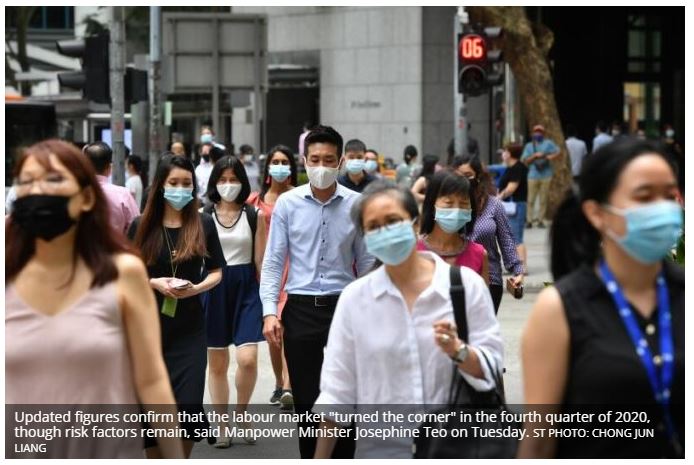Singapore labour market has ‘turned the corner’ but risks remain: Josephine Teo
UPDATED figures confirm that the labour market “turned the corner” in the fourth quarter of 2020, though risk factors remain, said Manpower Minister Josephine Teo at the release of the Labour Market Report on Tuesday.
These risks include the lack of a major reopening of international borders, the tapering off of government support schemes, and mismatch between jobseekers and employers, she said.
Moving on from last year’s priority of keeping workers employed, this year’s efforts will turn more towards helping workers find roles that are an ideal fit, she added.
The latest report painted a picture of the labour market that was broadly similar or even better than that suggested by the advance release on Jan 28, showing a “broad improvement” by the fourth quarter.
Additional indicators in Tuesday’s release reinforced this picture, with an improvement in the re-entry rate for retrenched residents, and a rise in job vacancies.
While the labour market has adjusted in 2020, a large part of this adjustment was borne by foreign employment, noted permanent secretary (manpower) Aubeck Kam.
In the fourth quarter, total employment excluding foreign domestic workers declined by 7,900, slowing from the third quarter’s 29,100 fall. The decline was due solely to non-residents, with resident employment continuing to rise, up 34,500.
For the full year, total employment was down 166,600, again solely due to non-residents. Resident employment had rebounded back above pre-Covid-19 levels by the end of the year, up 14,900 from the year before.
Retrenchments eased in the fourth quarter after rising for five straight quarters, with 5,640 retrenchments. This took the full-year figure to 26,110, more than double the figure in 2019.
But the incidence of retrenchment was lower than in past recessions, at 12.8 per 1,000 employees overall, compared to an average of 22.5 per 1,000 in previous recessions.
For residents, the incidence was 11.1 per 1,000 employees, better than the non-resident incidence of 15.7.
Improvements notwithstanding, the labour market is “not out of the woods yet”, said Mr Kam, noting that unemployment rates remain elevated.
The annual average unemployment rates in Tuesday’s report were unchanged from the advance estimates, at 3 per cent overall, 4.1 per cent for residents, and 4.2 per cent for citizens.
Bucking the trend of improvement, the seasonally-adjusted resident long-term unemployment rate rose in December to 1.1 per cent, up from 0.9 per cent in September.
But this is usually a lagging indicator that is one of the last to turn the corner, said Mr Kam.
The 1.1 per cent rate is “not out of the ordinary”, given that greater slack in the labour market means that people will take longer to find jobs, said Ang Boon Heng, director of the manpower research and statistics department.
He noted that the rate was comparable to the peak after the global financial crisis (1.1 per cent) and lower than in some past recessions such as Sars (1.8 per cent).
Tuesday’s report also included additional indicators that were not in the advance release.
The re-entry rate for retrenched residents was 62 per cent for the full year, down from 64 per cent in 2019, and lower than in the global financial crisis, when it had been 65 per cent.
Nonetheless, the re-entry rate did improve in the fourth quarter after three straight quarters of decline, to 64 per cent.
Seasonally-adjusted job vacancies rose to 56,500 in December, which the Ministry of Manpower said partly reflects government support measures to encourage hiring.
This took the seasonally-adjusted ratio of job vacancies to unemployed persons to 0.77, improving from 0.63 in the previous quarter but still below the pre-Covid ratio of 0.82.
As business activities resumed, the number of employees in short work-week or temporary lay-off arrangements continued to fall in the fourth quarter, declining sharply to 8,710, from 34,240 in the previous quarter.
The average weekly total paid hours worked per employee also rose by half an hour, to 44.3 in December. For the full year, however, the figure was pulled down by the shorter hours worked during the “circuit-breaker” months and the phased reopening, at 44 hours.
The decline in hours worked also made for a divergence in measures of productivity. Real value-added per worker fell 3.4 per cent in 2020, but real value-added per actual hour work rose 1.3 per cent, supported by strong productivity gains in manufacturing despite declines in construction and services.
Overall, this is an “optimistic picture, but much work remains to be done”, said Mr Kam, citing ongoing tripartite efforts to support employers to expand local hiring, and support jobseekers in reskilling and upskilling.
Mrs Teo noted that ironically, as labour market conditions are seen to improve, jobseekers may hold out longer in the hope of a more suitable job, which may affect labour market figures in the coming months.
She acknowledged that last year, when the priority was to help workers stay in the workforce, some jobseekers may have taken up opportunities that were not “their preferred jobs”.
“What we want to focus on next… is to help them move into positions that are closer to their aspirations and closer to what makes best use of their skills,” she said.
Source: https://www.businesstimes.com.sg/government-economy/singapore-labour-market-has-turned-the-corner-but-risks-remain-josephine-teo


 Thailand
Thailand




